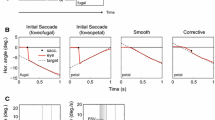Summary
Four subjects — all made large numbers of Express saccades in the normal gap task — were instructed to make saccades in the direction opposite to the side where a visual stimulus appeared (“anti” task). Gap and overlap trials were used. Saccadic reaction time (SRT), velocity and amplitude of the corresponding eye movements were analysed and compared to those of saccades made in the normal task. The velocity of “anti saccades” was found to be slightly (up to 15%) but significantly slower in two subjects. The distributions of SRTs in normal gap tasks show a small group of anticipatory saccades (with SRT below 80 ms and slower velocities) followed by a group of saccades with fast reaction times between 80 ms and 120 ms (Express saccades) followed by another large group ranging up to 180 ms (regular saccades). In the gap anti task there are anticipatory saccades and saccades with SRTs above 100 ms; Express saccades are missing. The distribution of SRTs obtained in the overlap anti task was unimodal with a mean value of 231 ms as compared to 216 ms in the normal task. The introduction of the gap therefore clearly decreases the reaction times of the anti saccades. Control experiments show that the delay of anti saccades is not due to an interhemispheric transfer time but must be attributed to the saccade generating system taking more time to program a saccade to a position where no visual stimulus appears. These data are discussed as providing further evidence for the existence of a reflex-like pathway connecting the retina to the oculomotor nuclei mediating the Express saccade.
Similar content being viewed by others
References
Boch R (1988) Chemical lesions in V1, V2 and V3 of the rhesus monkey: effects upon express-saccades. In: Elsner N, Barth F (eds) Proceedings of the 16th Göttingen Neurobiology Conference. Thieme, New York
Boch R, Fischer B (1986) Further observations on the occurrence of express-saccades in the monkey. Exp Brain Res 63: 487–494
Deubel H, Wolf W, Hauske G (1986) Adaptive gain control of saccadic eye movements. Human Neurobiol 5: 245–253
Doma H, Hallett PE (1988) Dependence of saccadic eye-movements on stimulus luminance, and an effect of task. Vision Res 28: 915–924
Findlay JM (1982) Global visual processing for saccadic eye movements. Vision Res 22: 1033–1045
Fischer B, Boch R (1983) Saccadic eye movements after extremely short reaction times in the monkey. Brain Res 260: 21–26
Fischer B, Breitmeyer B (1987) Mechanisms of visual attention revealed by saccadic eye movements. Neuropsychologia 25: 73–83
Fischer B (1987) The preparation of visually guided saccades. Rev Physiol Biochem Pharmacol 106: 1–35
Fischer B, Ramsperger E (1984) Human express saccades: extremely short reaction times of goal directed eye movements. Exp Brain Res 57: 191–195
Fischer B, Ramsperger E (1986) Human express saccades: effects of randomization and daily practice. Exp Brain Res 64: 569–578
Frost D, Pöppel E (1976) Different programming modes of human saccadic eye movements as a function of stimulus eccentricity: indications of a functional subdivision of the visual field. Biol Cybern 23: 39–48
Gauthier G, Volle M (1975) Two dimensional eye movement monitor for clinical laboratory recordings. Electroencephalogr Clin Neurophysiol 39: 285–291
Guitton D, Buchtel HA, Douglas RM (1985) Frontal lobe lesions in man cause difficulties in suppressing reflexive glances and in generating goal-directed saccades. Exp Brain Res 58: 455–472
Hallett PE (1978) Primary and secondary saccades to goals defined by instructions. Vision Res 18: 1279–1296
Hallett PE, Adams BD (1980) The predictability of saccadic latency in a novel voluntary oculomotor task. Vision Res 20: 329–339
Kalesnykas RP, Hallett PE (1987a) On plotting amplitude-transition functions for voluntary eye saccades. Vision Res 27: 675–679
Kalesnykas RP, Hallett PE (1987b) The differentiation of visually guided and anticipatory saccades in gap and overlap paradigms. Exp Brain Res 68: 115–121
Kapoula Z (1985) Evidence for a range effect in the saccadic system. Vision Res 25: 1155–1157
Mohler CW, Wurtz RH (1977) Role of striate cortex and superior colliculus in visual guidance of saccadic eye movements in monkeys. J Neurophysiol 40: 74–94
Ottes FP, van Gisbergen JA, Eggermont JJ (1984) Metrics of saccade responses to visual double stimuli: two different modes. Vision Res 24: 1169–1179
Ottes FP, van Gisbergen JA, Eggermont JJ (1985) Latency dependence of colour-based target vs nontarget discrimination by the saccadic system. Vision Res 25: 849–862
Posner MI, Walker JA, Friedrich FJ, Rafal RD (1984) Effects of parietal injury on covert orienting of attention. J Neurosci 4: 1863–1874
Reuter-Lorenz PA, Hughes HC, Fendrich R (1991) The reduction of saccadic latency by prior offset of the fixation point: an analysis of the gap effect. Percept Psychophys 49: 167–175
Robinson DL, Petersen SE, Keys W (1986) Saccade-related and visual activities in the pulvinar nuclei of the behaving rhesus monkey. Exp Brain Res 62: 625–634
Schiller PH, True SD, Conway JL (1979) Effects of frontal eye field and superior colliculus ablations on eye movements. Science 206: 590–592
Schiller PH, True SD, Conway JL (1980) Deficits in eye movements following frontal eye-field and superior colliculus ablations. J. Neurophysiol 44: 1175–1189
Schiller PH, Sandell JH, Maunsell JH (1987) The effect of frontal eye field and superior colliculus lesions on saccadic latencies in the rhesus monkey. J Neurophysiol 57: 1033–1049
Smit AC, van Gisbergen JA, Cools AR (1987) A parametric analysis of human saccades in different experimental paradigms. Vision Res 27: 1745–1762
Smit AC, van Gisbergen JA (1989) A short-latency transition in saccade dynamics during squarewave tracking and its significance for the differentiation of visually-guided and predictive saccades. Exp Brain Res 76: 64–74
Author information
Authors and Affiliations
Rights and permissions
About this article
Cite this article
Fischer, B., Weber, H. Characteristics of “anti” saccades in man. Exp Brain Res 89, 415–424 (1992). https://doi.org/10.1007/BF00228257
Received:
Accepted:
Issue Date:
DOI: https://doi.org/10.1007/BF00228257



